
| Genus List | Species List | Cephalotes Overview |Key to Minor Workers |
The soldier of peruviensis is unknown, but will probably key near curvistriatus or setulifer. Cephalotes atratus does not have a soldier caste.
10a. Eyes situated beneath the antennal scrobe (the groove in which the antenna is concealed), which extends above it to the vertex margin: alfaroi
10b. Eyes situated behind the scrobe, which terminates in front of the eye: 50

50a. Head with complete and strongly developed cephalic disk: 100
50b. Head lacking a cephalic disk, or disk only partially developed, or if completely developed (cristatus, middle figure below) the posterior border of disk very weakly developed: 500
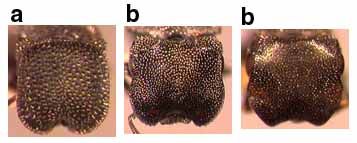
100a. Cephalic disk continuous anteriorly, frontal carinae meet anteriorly at a linear incision, mandibles completely hidden beneath frontal carinae: 150
100b. Cephalic disk with arcuate notch anteriorly; in full face view dorsal surface of mandibles visible in notch: 200

150a. Color largely black, with anterolateral margins of gaster yellow; cephalic disk subcircular, only slightly longer than wide: setulifer
150b. Color uniformly red brown; cephalic disk distinctly elongate: 170
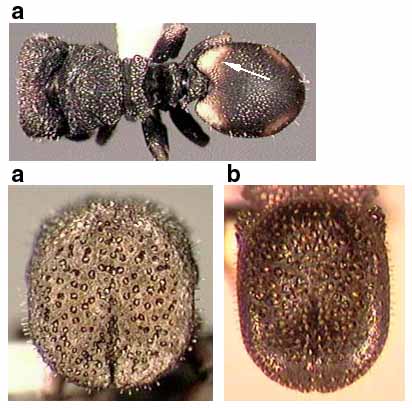
170a. Surface of cephalic disk mat, granular, with deep circular foveae bearing erect, pompon-like setae: porrasi
170b. Surface of cephalic disk shiny, with shallow foveae bearing appressed, linear setae: pallens

200a. Surface of cephalic disk almost entirely orange: 250
200b. Surface of cephalic disk mostly dark brown or black, at most an anterolateral portion of the frontal carinae reddish: 350
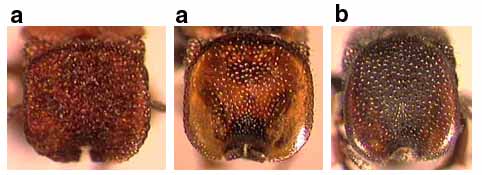
250a. Surface of cephalic disk largely smooth and shiny: 300
250b. Surface of cephalic disk coarsely rugose: grandinosus
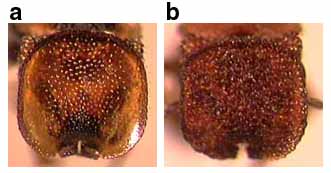
300a. Propodeum spinose: umbraculatus
300b. Propodeum with lateral foliaceous crest, not spinose: scutulatus
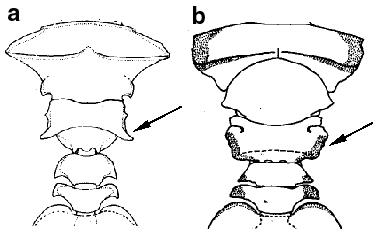
350a. Cephalic disk with foveae dense, separated by distance less then their diameters; lateral margins of posterior face of propodeum with foliaceous crest; first gastral tergite without erect setae: maculatus
350b. Cephalic disk with foveae small, separated by distance equal to or greater than their diameters; lateral margins of posterior face of propodeum carinate but without foliaceous crest; first gastral tergite with scattered short, stiff, erect setae: curvistriatus

500a. Propodeum with lateral foliaceous crest, lacking spines: multispinosus
500b. Propodeum with lateral spines, lacking foliaceous crest: 600

600a. In dorsal view, pronotum transversely elongate, much broader than long, about twice as wide as propodeum; face with weakly developed disk: cristatus
600b. In dorsal view, pronotum less transverse, less than twice as wide as propodeum: 700

700a. Anterior face of pronotum dull, not strongly shining; mandibles smoothly rounded, without differentiated lateral face and without projecting tubercle where dorsal surface meets frontal carina: minutus
700b. Anterior face of pronotum shiny; mandibles with differentiated lateral face that is flat to concave, and with dorsally projecting tubercle where dorsal surface meets frontal carina (with mandibles closed): 800
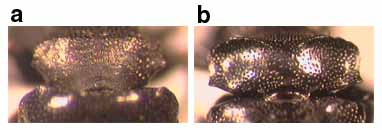
800a. At least posterior third of first gastral tergite with dense layer of appressed, foveate, silver-colored setae, giving glittered appearance: basalis
800b. First gastral tergite almost all smooth, shiny, and dark, with glittered appearance only weakly developed at anterolateral and posterior margins: cordiventris
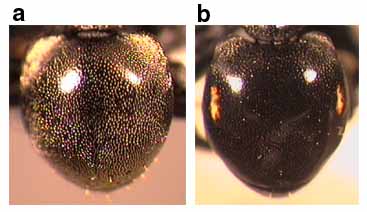
Page author:
John T. Longino, The Evergreen State College, Olympia WA 98505 USA.longinoj@evergreen.edu